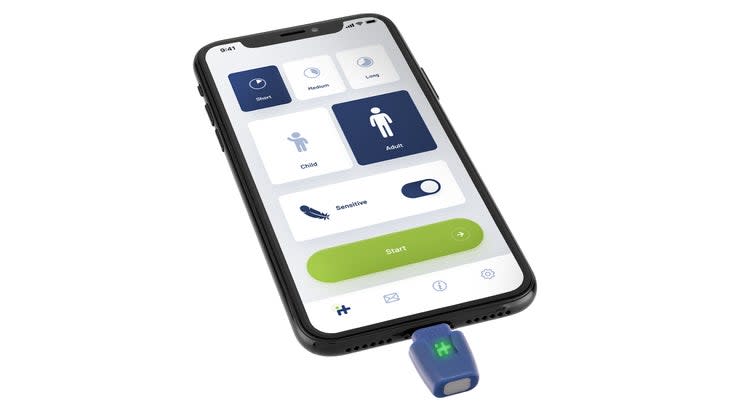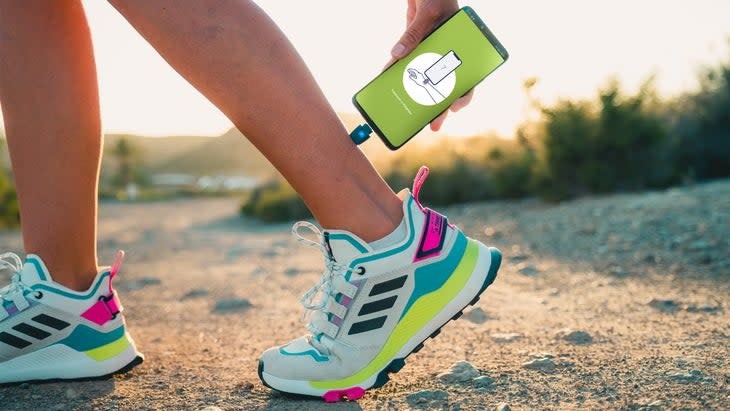The Device That Stops Mosquito Bites in Their Tracks
This article originally appeared on Outside
Here's one of very few things that, I wager, all humans can agree on: mosquito bites suck. I've spent much of my life battling it with antihistamine creams, alcohol wipes, ice cubes, and a raft of natural remedies that promised to end the irritation but ultimately left me disappointed. So in June, when a publicist sent me a smartphone accessory that claimed to cure the itch, I greeted it with the same skepticism that I reserve for fad diets.
The device, called Heat It, made by a German company and sold in that country since 2020, plugs into the charging port of a smartphone, draws power from its battery, translates that power to heat, and is then used to apply that heat directly to the bite site. It's about the size of my thumbnail and is controlled by a free app (iOS and Android).
Intrigued, I installed it on my iPhone so I'd be ready for the next testing opportunity--which presented itself the following morning. My daughter is one of those unlucky people who inexplicably attracts mosquitoes where none seem to exist, and she arrived at the breakfast table with a fresh white welt that hadn't yet matured into pink or red.

I grabbed my phone, opened the app, and followed the prompts that open automatically when you insert the device (which only works when connected to a phone). Three settings (for recipient age, treatment duration, and skin sensitivity) let you adjust the output. Since my daughter is 12, I chose the "child/short/sensitive" combination for our first use. The app told us when Heat It was ready to be applied to her skin, and then a timer counted down for four seconds to an audible chime that indicated the end of treatment.
She was startled by the heat, but unhurt, and by the time breakfast ended, she announced that the bite no longer itched. Even the swelling appeared to have diminished. All that day, she never felt compelled to scratch, which is a huge improvement over her typical routine in which she scratches mosquito bites into open wounds that make her skin look like pepperoni pizza.
That initial success triggered a flurry of use by me, my husband, and our bite-prone kid. We zapped new welts and old ones, becoming fairly addicted to the gizmo this summer. Because, damn: it works.
Really large bites and ones that are several days old seem more resistant to the treatment so that after a few hours of relief, the itch sometimes returns (we zap them again for renewed comfort). On new bites, Heat It usually stops the itch altogether, even when treated with the short setting. The eight-second, long setting feels fairly intense, especially at the adult level, so we save that one for maddening mega-bites on fleshy body parts (extended treatment proved to be too painful when applied to thin-skinned zones, such as the shin).
Visually, the redness lingers for a few days, but without the accompanying prickle. It's the best thing that's happened to summer since watermelon.
It seemed too good to be true, so I called Adam Friedman, MD, a professor who chairs the dermatology department at George Washington School of Medicine and Health Sciences, to learn what makes Heat It work--and whether it's medically safe and legit.
"It makes sense that it works," says Friedman. He explains that we feel itchy when our bodies' immune systems react to foreign substances that insects secrete when they bite us--or in mosquitoes' case, saliva that numbs the skin so we don't feel their blood draws. That immune response causes our skin cells to swell, our blood vessels to redden, and our nerves to get sensitized. But those same nerves also transmit temperature, says Friedman, "So the thinking is that if you can overwhelm the nerves with heat, you can obscure the itch."
That validates why some people champion the folk remedy of heating a spoon and pressing it onto the bite site. But such methods, says Friedman, pose the risk of burning the skin. "If [heat] is well controlled, it could help with the itch of a bug bite," he continues. And since scratching often opens the skin and introduces bacteria that live beneath fingernails and commonly cause staph and strep infections, heat treatment strikes Friedman as being better than the alternatives. Certainly, our family can attest to that improvement.
But effective heat control is key, Friedman says. So he questioned the settings used by Heat It and its related app. "How are the settings defined?" he says. "What body of evidence dictates, for example, what the 'sensitive' mode should be?"
I put that question to Heat It founder Lukas Liedtke, who developed the product after a friend loaned him a larger, battery-operated heat stick to treat his mosquito bites. "[Similar products are] very common in Germany," says Liedtke, who estimates that 60 to 70 percent of that country's households own and use some sort of heat applicator (like Bite Away) to quell insect-caused itching.

Liedtke's innovation was to make a much smaller and lighter device that exploited the battery and control capability of something that most people already carry with them everywhere: their smartphone. The dime-sized Heat It clips to a lanyard, which makes it easy to carry and locate. Its plastic housing includes a heat adjuster, a microcontroller, and a medical-grade ceramic element that warms to 124 degrees Fahrenheit.
As for those treatment settings, the company established them after collecting user data representing some 12,000 uses. In Europe, Heat It achieved classification as a medical device--a process that relied on abundant data demonstrating the device's safety and efficacy. "We did a mess of studies," says Liedtke, adding that Heat It recorded subjects' responses during and after treatment to determine the device settings and measure effects. "We see an 80 percent reduction in itching and pain within the first minute," he notes.
After receiving USDA approval this year, Heat It entered the U.S. market in June with REI Co-Op and Amazon. "In the U.S., only five percent of people have ever heard of this [heat treatment] principle," says Liedtke. So the sales potential is significant, but only if shoppers understand and embrace the approach, he says. "It's taken a lot of work to educate people.".
I, for one, needed to feel it to believe it. The app functions perfectly, with no crashes or apparent bugs. Using the device registers no drain on my phone's battery. And in our family, Heat It actually stops our mosquito bites from itching, resulting in the first summer that my kid hasn't resembled a shotgun target. Consider me a convert.
For exclusive access to all of our fitness, gear, adventure, and travel stories, plus discounts on trips, events, and gear, sign up for Outside+ today.

